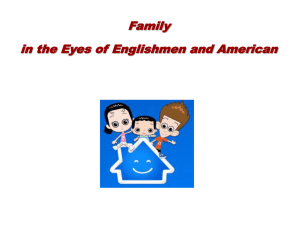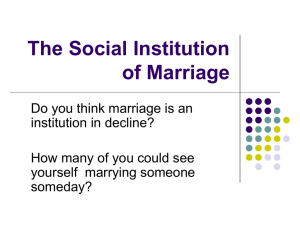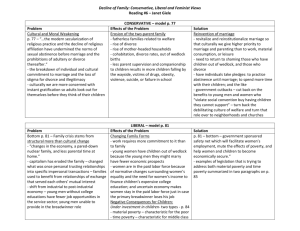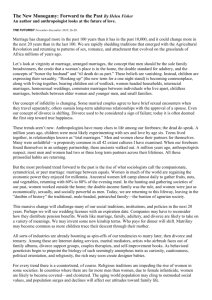Chapter 8 Love Relationships
advertisement
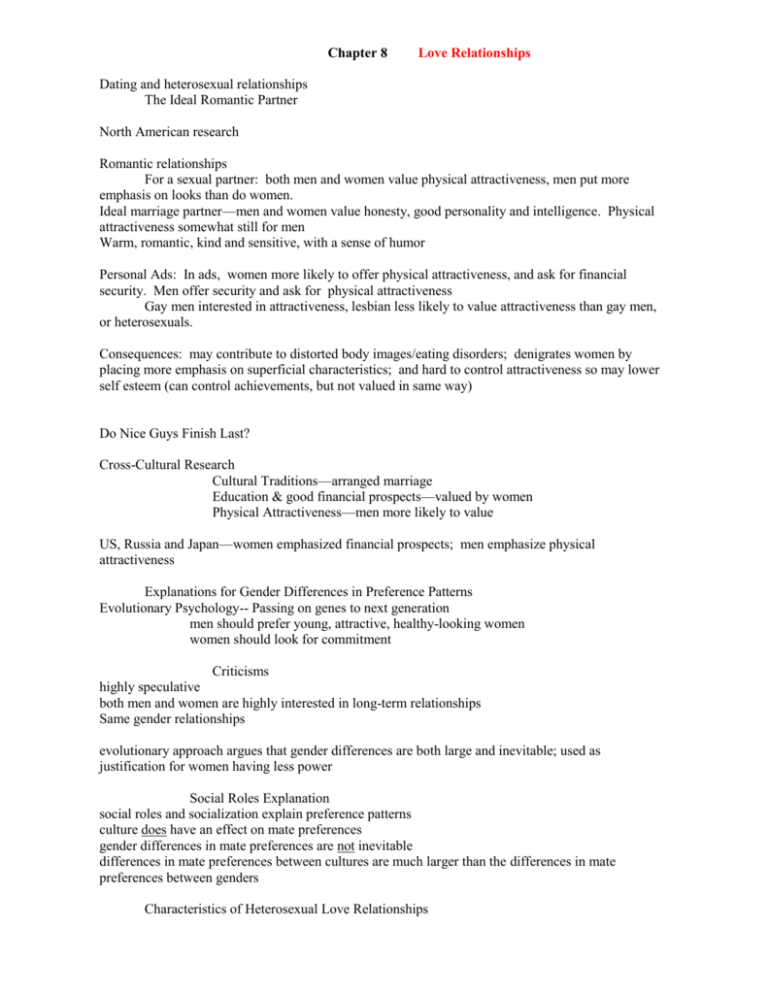
Chapter 8 Love Relationships Dating and heterosexual relationships The Ideal Romantic Partner North American research Romantic relationships For a sexual partner: both men and women value physical attractiveness, men put more emphasis on looks than do women. Ideal marriage partner—men and women value honesty, good personality and intelligence. Physical attractiveness somewhat still for men Warm, romantic, kind and sensitive, with a sense of humor Personal Ads: In ads, women more likely to offer physical attractiveness, and ask for financial security. Men offer security and ask for physical attractiveness Gay men interested in attractiveness, lesbian less likely to value attractiveness than gay men, or heterosexuals. Consequences: may contribute to distorted body images/eating disorders; denigrates women by placing more emphasis on superficial characteristics; and hard to control attractiveness so may lower self esteem (can control achievements, but not valued in same way) Do Nice Guys Finish Last? Cross-Cultural Research Cultural Traditions—arranged marriage Education & good financial prospects—valued by women Physical Attractiveness—men more likely to value US, Russia and Japan—women emphasized financial prospects; men emphasize physical attractiveness Explanations for Gender Differences in Preference Patterns Evolutionary Psychology-- Passing on genes to next generation men should prefer young, attractive, healthy-looking women women should look for commitment Criticisms highly speculative both men and women are highly interested in long-term relationships Same gender relationships evolutionary approach argues that gender differences are both large and inevitable; used as justification for women having less power Social Roles Explanation social roles and socialization explain preference patterns culture does have an effect on mate preferences gender differences in mate preferences are not inevitable differences in mate preferences between cultures are much larger than the differences in mate preferences between genders Characteristics of Heterosexual Love Relationships Gender Comparisons friendship women report: liking, commitment, satisfaction also more negative emotions attached: sadness, depression, hurt, loneliness Men and women both rat trust, caring, honesty, respect strategies for maintaining a romantic relationship—women Factors Related to Satisfaction with the Relationship friendship —both men and women more satisfied with relationship if based on friendship skill at expressing emotions—when both able to express emotions Breaking Up women feel more joy and relief men & women report similar negative emotions picking up the signals—who is better? ambivalence coping—blame, distractions Marriage and Divorce Women more likely to to eagerly anticipate getting married Average ages for first marriage—25-women; 27-men Canada—28yrs women, 30 yrs man ½ North Americans married Marriage rates and ethnicity Marital Satisfaction Satisfaction During Various Periods of Marriage Young couples happiest. change over time—20-24 yrs marriage least satisfied, then starts to improve, children grown Satisfaction During Various Periods of Marriage newlyweds expectations and resentments changes and satisfaction Gender Comparisons in Marital Satisfaction Women more likely to report that marriage did not live up to ideal and wish they could change something in marriage; women more sensitive to problems in relationship both men and women happier if married than if not married???? Characteristics of Happy Marriages—both feel emotional needs being met, high regard from partner— happiest in marriage when felt valued 1. Emotional Stability 2. Communication skills and understanding, 3. More positive comments, rather than negative comments, 4. Strong Conflict-resolution skills, 5. Trust in the other person, 6. Mutual support, 7. Belief that each spouse has genuine concern about other’s well-being 8. Flexibility, 9. Equal sharing of household tasks, 10. Equal sharing in decision making. Way each person interprets spouse’s action significant for happy vs unhappy Responsibility and Power in Marriage Salary and Power—money=power research: the more money husbands earn the more power in decision making and less domestic tasks performed Wives: when earn more than husband—not equal with financial matters Three Patterns of Power Distribution Traditional Marriage—husband more dominant, traditional gender roles Modern Marriage—wife “junior partner”, say more equal, but man tends to be more powerful wife’s work secondary Egalitarian Marriage—share power equally, without traditional roles companionship/sharing Marriage and Women of Color Fewer studies of marriage patterns in ethnic groups Latnina—obligation to their family Machismo and marianismo Black women—research on economically poor families Later research—egalitarian marriage more common Asian American—expected to marry from own ethnic group Divorce 40 to 65% divorce rate Cohabitation and Divorce Couples who live together before marriage are more likely to get divorced. Cohabitation does not necessarily cause divorce. Cohabitation: ½ of 1st marriages cohabitated. Women may see more freedom from traditional roles in marriage. happier than than single people, not as happy as married. Divorce rates higher, may be due to: Selection effect: attitudes of ind. who cohabit are more accepting of divorce and less commited to marriage than attitudes of non-cohabitors. Decision to divorce Wives initiate divorce more often than husbands do Reasons for divorce: physical or emotional abuse; infidelity; drug or alcohol abuse Psychological Effects of Divorce Transitions and separations—make it painful Stress, depression and anger Positive feelings-may have been constrained in marriage Financial Effects of Divorce A woman's financial situation is usually worse following a divorce, especially if she has children Many fathers fail to pay child support Black mothers are even more likely than White mothers to face financial problems Lesbians and Bisexual Women Lesbian—psychologically, emotionally and sexually attracted to other women Sexual Minority—anyone with same gender attraction Heterosexism—bias against homosexuals The Psychological Adjustment of Lesbians homosexuality is not a mental disorder the average lesbian is as well adjusted as the average heterosexual woman in some studies, lesbians higher in self-esteem, self-sufficiency, ease of decision making Likely to report a history with Hate crimes Depression, Anxiety Lesbians who accept their lesbian identity have higher self-esteem than those who have not accepted their lesbian identity Community & Family Characteristics of Lesbian Relationships The Beginning of a Relationship Equality in Lesbian Relationships Equal decision making more important than equal salary Housework Satisfaction similar to heterosexual couples and gay male couples Relationship Commitment Psychological Intimacy Breaking Up Similar reasons;Same mix of emotions Fewer factors preventing break up Less support for relationship Lack of support after break up Lesbian Women of Color Intersectionality Legal status of lesbian relationships Bisexual women Single Women Single women: substantial %age of adult women, yet little research conducted on this group. Many single women highly educated and career-oriented—singlehood allows more flexible work hours and geographic mobility Chose not to marry—did not find ideal partner Characteristics of Single Women—2000 census—about 23% women over 18 had never married, 27% Canadian more likely to work outside the home choosing not to marry similar to married women in psychological distress, life span higher than marred women on independence lower than married women on self-acceptance Social relationships Romantic status People in 1990’s—less likely to use “old maid, spinster” 1970—10% 25-29 yr olds unmarried 2000—39% Attitudes Toward Single Womena; Singleism 1980’s research—single women perceived to be less sociable, less attractive and less reliable Similarities in these areas to married women: in scores on measures of psychological distress; life span; live longer than divorced women. Single women score higher on measures of independence, lower on self-acceptance tests. Poll--sample of New York heterosexual women, ages 21-40: 34% happily single and dating; 27% happily single and not dating. 30% looking for romantic relationship, 5% described self as “panicking”. trend in number of women remaining single—“increasing recognition that singlehood can be legitimate, healthy and happy alternative to marriage” Advantages and Disadvantages of Being Single Freedom—do what they want Privacy—be by themselves Free to be themselves Self-knowledge Loneliness Cultural bias Create own Social networks Single women of color Chapter 8 Trait Approach Type A/Type B Behavior Research on the Type A behavior pattern developed out of predictions made by cardiologists about who suffers heart attacks. Among other behaviors related to this personality trait, Type A people generally perform better in achievement situations than Type B's. Type A/Type B Behavioral Patterns Type A - a cluster of characteristics—excessive competitiveness, hard drivenness, impatience, and hostility—thought to be related to the incidence of heart disease. Type B - reflected in individuals who are relaxed and easy going. Early researchers found a strong link between Type A behavior and cardiovascular problems, later studies did not always replicate these fndings. Two explanations for this: the way researchers measure Type A and recognizing that anger and hostility is the Type A component related to health problems. Research suggests that the Type A’s toxic core is negative emotion, especially hostility (a potent form of anger). Hostility is the characteristic most consistently associated with coronary problems. A key difference between Types A and B—Type A seem to react to several types of stress with larger increases in pulse rate and blood pressure. In one study (both personality types) subjects forewarned that they would receive electric shock for errors on a difficult task: recalling long strings of numbers read aloud only once. Under this stressful condition, Type A individuals showed a significantly higher increase in pulse rate and blood pressure than did Type Bs. Contrasting patterns in social behavior-- Type As tend to be more impatient with others and become angry when other people hold them back in any way. Type As report feeling less comfortable around others than do Type Bs. They prefer to work alone rather than as a team, and they seem to resent being told what to do. Types As are more ready to do the opposite of what is demanded of them. Type A and work performance--Type As seem to work faster even when no pressure or deadline is involved. They complain less about hard work and report being less tired when it is finished. Type As do more poorly on tasks requiring patience or careful, considered judgment. Surveys indicate that most members of top management are Type Bs, not Type As. (perhaps As don’t survive to make it) the impatient, hurried style of Type A is not compatible with the skills needed of top-level executives. Type As do better on tasks involving time pressure or solitary work. Type Bs may do better on tasks requiring complex judgment, accuracy rather than speed, and working as part of a team. Hardiness Hardiness is a personality style characterized by a sense of commitment, control, and a perception of problems as challenges. Studies have shown individuals with a hardy personality are less likely to succumb to illness when exposed to stressful situations. Levels of illness dropped most dramatically when hardiness was combined with exercise and social support in the face of stress Social Anxiety Social anxiety is a trait dimension indicating the extent to which people experience anxiety during social encounters or when anticipating social encounters social anxiety: increased physiological arousal, inablitity to concentrate, and feelings of nervousness. Recognize the source of discomfort from social encounter having or will have. Believed to be relatively stable tendency for people to experience social anxiety. Continuum—most everyone can be found on continuum of how much anxiety typically experience. Similar to shyness, stage fright, reticence. Dating anxiety and stage fright—specific examples Differences between introversion and shyness—shy people report anxiety often very painful—want to be more sociable. Introverts—often choose to be by themselves. Characteristics of socially anxious people. Difficult time in many social situations. Report feel awkward and nervous when talking to others. Concerned with what others think of them, become self conscious Think about what they are doing wrong—how stupid must sound, how foolish they must look. Stumble over words, say wrong things show outward signs nervousness Interpret feedback from others in negative way—so expect interactions to not go well. Evaluation apprehension is underlying cause: A strong concern about receiving negative evaluation from others. Afraid of what other people think of them—fearful of others finding them to be foolish, boorish or immature. Thinking about blind date, speech, or meeting new people becomes a horrible experience— situations that are likely to consist of evaluation or judgment by others. Do things to reduce fear of what others think—avoid encounter, skip parties etc., or reduce amount of social interaction. Short conversations, non threatening topics. Self protective Methods of reducing social anxiety relate to idea that it is initiating conversation most difficult, once talking do ok at conversation. Shy people thought to lack confidence in ability to make good impression—so therapy helps by focus on belief that capable of saying right thing and of making good impression. Emotions can be examined in terms of relatively stable individual differences---certain emotions seem to go together Emotional Affectivity Emotional Intensity Emotional expressiveness Emotional affectivity. The extent to which people typically experience positive and negative emotions. Emotions can be placed along two major dimensions Positive affect--- Active, content, satisfied—other extreme--sad and lethargic. Negative affect—nervousness, anger, distress—other end---calm and serene Positive affect consistently related to social activity—higher in positive affect more likely to be involved in more social activities. More likely to be involved in satisfying romantic relationships. Able to act in ways that helps them make friends—pleasant and engaging. Negative affect—related to psychological stress, suffer from emotional problems. Likely to complain about health. Emotional intensity--- The strength or degree to which people typically experience their emotions. From typically mild to strong emotional reactions. High intensity experience emotion more intensely with more variability. (Highs and lows) Main difference in how react to similar events. High intensity people tend to overestimate how things will affect them, and make conclusions on limited info. Emotional expressiveness: individual differences in the extent to which people express their emotions, extent to which people outwardly express their emotions. From highly expressive to show few outward signs of feelings Women more expressive than men, more expression of feelings—fewer problems in romantic relationship, and those who express tend to be better at reading others’ emotions. Emotional expression linked to psychological health—expressive found to be happier, less anxious and guilty, than those low in expressiveness. Less likely to be depressed. High expression higher in self-esteem. Optimism and Pessismism People can be identified along a continuum from dispositionally optimistic to dispositionally pessimistic. Dispositional optimism The extent to which a person typically adopts an optimistic or pessimistic approach to dealing with life's challenges Advantages of dispositional optimism: achieve more, high goals and believe can reach goals. Confident, do better with failure. Differences between optimists and pessimists when faced with stressful events? Optimist less anxious and depressed Coping strategies used by two kinds of personalities—active vs avoidant optimists typically deal more effectively with adversity, Optimists typically maintain higher levels of subjective well-being during times of stress than do people who are less optimistic. A study of undergraduate students’ adjustment to their first semester of college indicated that optimism was associated with lower distress three months after starting school. postpartum depression in women having first child reported that initial optimism was inversely associated with depression three weeks postpartum, even when the initial level of depression was controlled statistically. Optimism benefits on physical well-being. A study conducted on men undergoing heart bypass surgery found that optimism is negatively associated with certain physiological changes that would make one susceptible to suffer a heart attack during surgery. Optimism predicted rate of recovery during the immediate postoperative period. Optimistic patients were more likely than pessimistic patients to have resumed vigorous physical exercise and to have returned to work full-time. Optimists cope in more adaptive ways than do pessimists--more likely to take direct action to solve their problems, are better at making plans to deal with adversity, and are more focused in their coping efforts. Optimists tend to accept the reality of the stressful situations they encounter, and they also seem intent on growing personally from negative experiences. They try to make the best of bad situations. Defensive pessimism: The tendency to attend to and worry about failure on upcoming tasks in a strategic effort to motivate oneself to do well. individuals deliberately focus on all the things that can go wrong in an effort to motivate themselves to do well. Does pessimism ever work? Nancy Cantor coined this term: Defensive pessimism: a cognitive strategy in which people set low expectations for a future performance despite having done well in similar situations in the past. setting low expectations helps “cushion” the blow of possible failure. people may use the strategy to reflect on what might happen, and give special attention to problems they might encounter. They work hard to prepare for the upcoming situation or performance. DP often feel anxious and out of control-- strategy helps harness their anxiety as motivation, with the result being a better performance. In addition to having negative expectations, they reflect extensively about possible positive and negative outcomes. Defensive pessimists manage anxiety through extensive reflection about possible outcomes, optimists distract themselves to avoid anxiety and thereby maintain their positive outlook. Both perform well in tasks in which they are allowed to pursue these respective strategies. Defensive pessimists perform more poorly if they are instructed to focus only on positive outcomes and strategic optimists perform more poorly if they are encouraged to reflect about the upcoming task.





